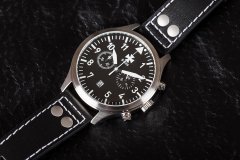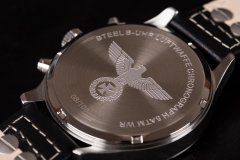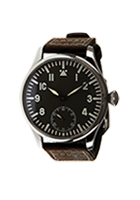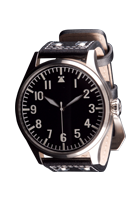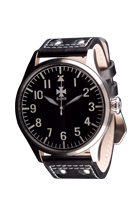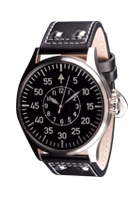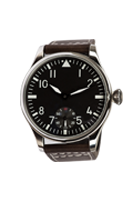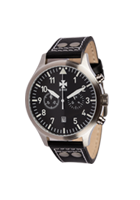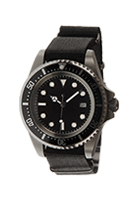|
|
B-UHR LUFTWAFFE flieger chronograph, limited edition PRICE: US $ 250.00 500.00 by click to BUY NOW button, you agree with terms and conditions CASE: a stainless steel polished case, 42 mm MOVEMENT: quartz precize movement, chronograph, date CROWN: stainless steel crown DIAL: Black matte dial HANDS: Hour hand Superluminova C3, minute hand Superluminova C3, second hand CASEBACK: stainless steel GLASS: antireflective BAND: extra thick heavy duty leather band with rivets BUCKLE: Alloy buckle with iron cross decoration, parts from me-109 fighter were used in alloy |

|
LUFTWAFFE flieger chronograph - LEGENDThe Luftwaffe was the aerial warfare branch of the German Wehrmacht during World War II. Germany's military air arms during the First World War, theLuftstreitkräfte of the Army and the Marine-Fliegerabteilung of the Navy, had been disbanded in 1920 as a result of the terms of the Treaty of Versailles which stated that Germany was forbidden to have any air force. During the interwar period, German pilots were trained secretly in violation of the treaty at Lipetsk Air Base. With the rise of the Nazi Party and the repudiation of the Versailles Treaty, the Luftwaffe was established on 26 February 1935. The Luftwaffe's Condor Legion fought during the Spanish Civil War, the conflict became a testing ground for new doctrines and aircraft. As a result, the Luftwaffe grew to become one of the most sophisticated, technologically advanced and battle-experienced air forces in the world, when war began in Europe in 1939.[4] By the summer of 1939, the Luftwaffe had twenty-eight Geschwaders (wings). The Luftwaffe was instrumental in contributing to the German victories across Poland and Western Europe. During the Battle of Britain, however, despite causing severe damage to the RAF's infrastructure and British cities during the subsequent Blitz, it did not achieve victory. The Allied bombing campaigns from 1942gradually destroyed the Luftwaffe's fighter arm. The Luftwaffe was also involved in operations over the Soviet Union, North Africa and Southern Europe. Despite its belated use of advanced turbojet and rocket propelled aircraft for the destruction of Allied bombers fleets, the Luftwaffe was overwhelmed by the Allies' superior numbers and improved tactics, and a lack of trained pilots and aviation fuel. A last-ditch effort to win air superiority was launched, during the closing stages of theBattle of the Bulge, in January 1945 failed. With rapidly dwindling supplies of petroleum, oil and lubricants after this campaign, and as part of the entire Wehrmachtmilitary forces as a whole, the Luftwaffe ceased to be an effective fighting force and after the defeat of the Third Reich, the Luftwaffe was disbanded in 1946. The Luftwaffe had only two commanders-in-chief throughout its history: Hermann Göring and latterly Generalfeldmarschall Robert Ritter von Greim. |






